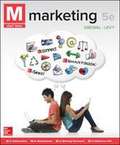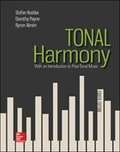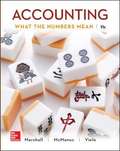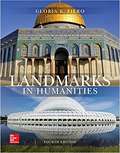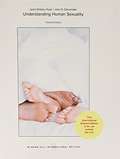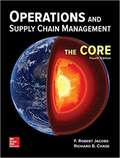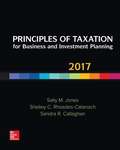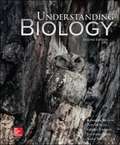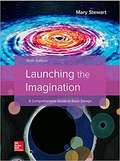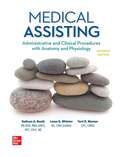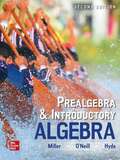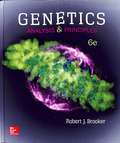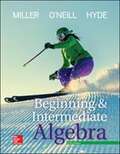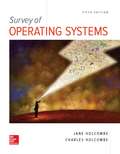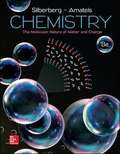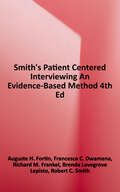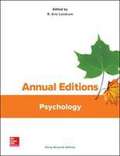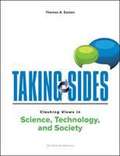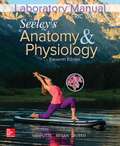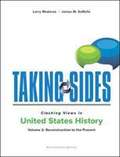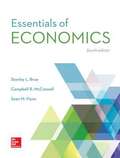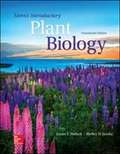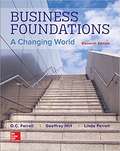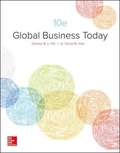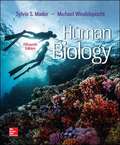- Table View
- List View
M: Marketing
by Dhruv Grewal Michael LevyM: Marketing is the most concise, impactful approach to Principles of Marketing on the market, with tightly integrated topics that explore both marketing fundamentals and new influencers, all in an engaging format that allows for easy classroom and assignment management. A robust suite of instructor resources and regularly updated Grewal/Levy author blog provide a steady stream of current, fresh ideas for the classroom.
Tonal Harmony
by Stefan Kostka Dorothy Payne Byron AlménFor a generation of professionals in the musical community, Tonal Harmony has provided a comprehensive, yet accessible and highly practical, set of tools for understanding music. With this new edition, twenty-first century technology meets a time-honored tradition. Now available in McGraw-Hill’s Connect® with SmartBook®, students are better equipped to understand and master the vocabulary of music efficiently,allowing them to move on more quickly to advanced musical skill-building.
Accounting: What the Numbers Mean
by David H. Marshall Wayne William McManus Daniel F. VieleAccounting has become known as the language of business. This new edition is written to meet the needs of those students who will not be accountants but who do need to understand accounting to learn the key language that embarks us in the business world. Marshall, the leading text in the Survey market, takes readers through the basics: what accounting information is, what it means, and how it is used. The authors help students succeed through clear and concise writing, a conceptual focus and unparalleled technology support. In using this text, students examine financial statements and discover what they do and do not communicate. This enables them to gain the crucial decision-making and problem-solving skills they need in order to succeed in a professional environment.
Landmarks in Humanities
by Gloria FieroLandmarks in Humanities is a single-volume survey of global culture designed to help students of humanities cultural history and history of the arts to understand and appreciate the relevance of historical works and ideas to their own daily lives. In chronological sequence Landmarks guides students on a journey of the most notable monuments of the human imagination and the most prominent ideas and issues that have shaped the course and character of the world’s cultures from prehistory to the present. The landmarks that mark this journey are the great works of their place and time and in some cases of all time.The text reflects the author's extensive background in the study of Humanities which has enabled her to craft a narrative that is at once brief and comprehensive giving students a thorough understanding of the interrelatedness of various modes of expression—art and architecture literature philosophy and music--without overwhelming them with detail. Each of the text's fifteen chapters is centered on a key idea related to the period being discussed and contains a series of valuable pedagogical features including timelines high-quality maps and boxed material. Each chapter also takes a unique cultural or historical point of view often through primary sources the stylistic relationship between two or more images and ideas or between text and image and contemporaneous non-Western cultural landmarks and cross-cultural influences.In this edition each chapter opens with “A First Look” at a landmark work that illustrates the key idea of the chapter and acts as a cultural guidepost to that chapter’s overarching theme. This new feature explains the artwork’s significance as a landmark in its own time as well as in ours.
Understanding Human Sexuality
by Janet S. HydeThis trusted text examines the biological, psychological, and sociological perspectives of human sexuality and provides practical information needed for everyday living, all with a firm grounding in research. The thoroughly revised thirteenth edition of Hyde, Understanding Human Sexuality, features a new emphasis on critical thinking skill development, with input from expert Diane Halpern to ensure clarity and accessibility for students. The author team features a unique combination of a psychologist and a sociologist, which gives this text a distinct interdisciplinary perspective.
Operations And Supply Chain Management: The Core
by Richard B. Chase F. Robert JacobsThe fourth edition of Operations and Supply Chain Management: The Core focuses on the important core concepts in the dynamic field of operations. Just as lava flows from the core of the earth, operations and supply chain management is the core of business. Material must flow through supply chain processes to create cash output and input. This new edition has an increased focus on supply chain analytics involving the analysis of data to better solve business problems. Connect is the only integrated learning system that empowers students by continuously adapting to deliver precisely what they need, when they need it, and how they need it, so that your class time is more engaging and effective
Principles of Taxation for Business and Investment Planning (2017 Edition)
by Shelley Rhoades-Catanach Sally M. JonesPrinciples of Taxation for Business and Investment Planning focuses on the role taxes play in business and investment decision, presenting the general roles of taxation and discussing its implications for all tax-paying entities before delving into a specific exception. The benefit of this approach is a strong grasp of the fundamental principles informing taxation rules. This helps students comprehend the framework of the tax system, making future changes to the tax code easier to understand-no matter how many there are. Unlike traditional introductory texts, Principles of Taxation for Business and Investment Planning downplays the technical detail that makes the study of taxation such a nightmare for business students. This text attempts to convince students that an understanding of taxation is not only relevant but critical to their success in the business world. Don't just teach your students the tax code; teach them how the tax code affects business decision making with the 2017 edition!
Understanding Biology
by George Johnson Jonathan Losos Kenneth Mason Susan Singer Tod DuncanA concise and engaging biology text for biology majors, Understanding Biology partnered with Connect emphasizes fundamentals concepts to help students better understand biology and focus on developing scientific skills. <p><p> Condensed chapters are centered on a learning path that serves to connect concepts within a chapter. The learning path begins with learning outcomes, which help students understand the core skills and concepts they should develop. Inquiry and Analysis cases help students build scientific skills, while scaffold end of chapter assessment ensures they not only grasp core concepts, but can also critically analyze and apply what they've learned. "Connecting the Concepts," a synthesis feature that ends every part, helps students understand the connections between biological concepts, thus helping them "see" the big picture.
Launching the Imagination: A Comprehensive Guide to Basic Design
by Mary StewartLaunching the Imagination treats design as both a verb and a noun―as both a process and a product. Design is deliberate―a process of exploring multiple solutions and choosing the most promising option. Through an immersion in 2-D 3-D and 4-D concepts students are encouraged to develop methods of thinking visually that will serve them throughout their studies and careers.
Medical Assisting: Administrative and Clinical Procedures
by Kathryn A. Booth Terri D. Wyman Leesa WhickerThe medical assisting profession is soaring to new heights with the expansion and diversity of roles and changes in the healthcare environment. Today’s medical assistants must juggle many tasks in the medical office to keep up with the changes. <p><p>The seventh edition of Medical Assisting: Administrative and Clinical Procedures with Anatomy and Physiology was updated to help students as well as instructors learn these ever-changing tasks and stay current in the healthcare environment.
Prealgebra and Introductory Algebra
by Julie Miller Molly O'Neill Nancy HydeCreate more lightbulb moments with this comprehensive set of valuable content and insightful, intuitive digital learning resources! This new 2nd edition of the Miller/O'Neill/Hyde Prealgebra and Introductory Algebra text seeks to serve the changing dynamics of today's curriculum by thoughtfully interweaving the topics of two foundational building blocks in students' mathematical journey. The text reflects the compassion of its experienced author team with features developed to address the specific needs of today's prealgebra and introductory algebra students. Included alongside the highly-favorable Problem Recognition Exercises, readers will find added review material, aimed at assisting students with synthesis, summarization, and recognition of key mathematical topics so as to enhance their overall conceptual understanding. These types of exercises, along with the overall number of practice problems and group activities available, permit instructors to choose from a wealth of problems, allowing ample opportunity for students to practice what they learn in lecture to hone their skills.
Genetics: Analysis And Principles
by Robert J. BrookerIn the sixth edition of Genetics: Analysis & Principles, the content has been updated to reflect current trends in the field. In addition, the presentation of the content has been improved in a way that fosters active learning. As an author, researcher, and teacher, I want a textbook that gets students actively involved in learning genetics. To achieve this goal, I have worked with a talented team of editors, illustrators, and media specialists who have helped me to make the sixth edition of Genetics: Analysis & Principles a fun learning tool. <p><p> Overall, an effective textbook needs to accomplish four goals. First, it needs to provide comprehensive, accurate, and up-to-date content in its field. Second, it needs to expose students to the techniques and skills they will need to become successful in that field. Third, an effective textbook should have pedagogical features, such as formative assessment, that foster student learn¬ing. And finally, it should inspire students so they want to pursue that field as a career. The hard work that has gone into the sixth edition of Genetics: Analysis & Principles has been aimed at achieving all four of these goals!
Beginning and Intermediate Algebra
by Julie Miller Molly O'Neill Nancy HydeGet Better Results with high quality content, exercise sets, and step-by-step pedagogy! The Miller/O'Neill/Hyde author team continues to offer an enlightened approach grounded in the fundamentals of classroom experience in Beginning and Intermediate Algebra 5e. <p><p>The text reflects the compassion and insight of its experienced author team with features developed to address the specific needs of developmental level students. Throughout the text, the authors communicate to students the very points their instructors are likely to make during lecture, and this helps to reinforce the concepts and provide instruction that leads students to mastery and success. <p><p>Also included are Problem Recognition Exercises, designed to help students recognize which solution strategies are most appropriate for a given exercise. These types of exercises, along with the number of practice problems and group activities available, permit instructors to choose from a wealth of problems, allowing ample opportunity for students to practice what they learn in lecture to hone their skills. In this way, the book perfectly complements any learning platform, whether traditional lecture or distance-learning; its instruction is so reflective of what comes from lecture, that students will feel as comfortable outside of class as they do inside class with their instructor.
Survey of Operating Systems (Fifth Edition)
by Charles Holcombe Jane HolcombeInformation technology (IT) offers many career paths, leading to occupations in such fields as PC repair, network administration, telecommunications, Web development, graphic design, and desktop support. To become competent in any IT field, however, you need certain basic computer skills. This book will help you build a foundation for success in the IT field by introducing you to fundamental information about desktop operating systems, a needed basis for working with computers at any level.
Chemistry: The Molecular Nature Of Matter And Change
by Martin Silberberg Patricia AmateisChemistry: The Molecular Nature of Matter and Change by Martin Silberberg and Patricia Amateis has been recognized in the general chemistry market as an unparalleled classic. The revision for the eighth edition focused on continued optimization of the text. <p><p> To aid in this process, we were able to use data from literally thousands of student responses to questions in LearnSmart, the adaptive learning system that assesses student knowledge of course content. The data, such as average time spent answering each question and the percentage of students who correctly answered the question on the first attempt, revealed the learning objectives that students found particularly difficult, which we addressed by revising surrounding text or adding additional learning resources such as videos and slideshows. <p> The text still contains unprecedented macroscopic-to-microscopic molecular illustrations, consistent step-by-step worked exercises in every chapter, and an extensive range of end-of-chapter problems, which provide engaging applications covering a wide variety of interests, including engineering, medicine, materials, and environmental studies. <p> Changes have been made to the text and applications throughout to make them more succinct, to the artwork to make it more teachable and modern, and to the design to make it more simplistic and open.
Smith's Patient Centered Interviewing: An Evidence-based Method
by Robert C. Smith Auguste H. Fortin Francesca C. Dwamena Richard M. Frankel Brenda Lovegrove LepistoA comprehensive, evidence-based introduction to the principles and practices of patient communication in a clinical setting Smith's Patient-Centered Interviewing, Fourth Edition presents a step-by-step methodology for mastering every aspect of the medical interview. Readers will learn how to confidently obtain from patients accurate biomedical facts, as well as critical personal, social, and emotional information, allowing them to make a precise diagnosis, develop effective treatment plans, and forge strong clinician-patient relationships. <p><p>The most evidence-based guide available on the topic, Smith's Patient-Centered Interviewing, Fourth Edition applies the proven 5-step approach, which integrates patient- and clinician-centered skills to improve effectiveness without adding extra time to the interview duration. The book's user-friendly design features icons, boxed case vignettes, and the use of color to highlight key points, and the pedagogy includes learning practice exercises in each chapter.
Psychology (Annual Editions)
by R. Eric LandrumThe Annual Editions series is designed to provide convenient, inexpensive access to a wide range of current articles from some of the most respected magazines, newspapers, and journals published today. Annual Editions are updated on a regular basis through a continuous monitoring of over 300 periodical sources. The articles selected are authored by prominent scholars, researchers, and commentators writing for a general audience. <p><p> Each Annual Editions volume has a number of features designed to make them especially valuable for classroom use: an annotated Table of Contents, a Topic Guide, an annotated listing of supporting websites, Learning Outcomes and a brief overview for each unit, and Critical Thinking questions at the end of each article. Go to the McGraw-Hill Create™ Annual Editions Article Collection at www.mcgrawhillcreate.com/annualeditions to browse the entire collection. Select individual Annual Editions articles to enhance your course, or access and select the entire Landrum: Annual Editions: Psychology, 47/e ExpressBook for an easy, pre-built teaching resource.
Taking Sides: Clashing Views in Science, Technology, and Society
by Thomas A. EastonThe Taking Sides Collection on McGraw-Hill Create™ includes current controversial issues in a debate-style format designed to stimulate student interest and develop critical thinking skills. This Collection contains a multitude of current and classic issues to enhance and customize your course. You can browse the entire Taking Sides Collection on Create or you can search by topic, author, or keywords.
Laboratory Manual for Seeley's Anatomy and Physiology (11th Edition)
by Eric WiseLaboratory Manual For Seeley's Anatomy And Physiology, Eleventh Edition
Taking Sides: Clashing Views In United States History, Volume 2: Reconstruction To The Present
by Larry Madaras James M. SoRelleThe Taking Sides Collection on McGraw-Hill Create® includes current controversial issues in a debate-style format designed to stimulate student interest and develop critical thinking skills. This Collection contains a multitude of current and classic issues to enhance and customize your course. You can browse the entire Taking Sides Collection on Create or you can search by topic, author, or keywords. Each Taking Sides issue is thoughtfully framed with Learning Outcomes, an Issue Summary, an Introduction, and an "Exploring the Issue" section featuring Critical Thinking and Reflection, Is There Common Ground?, Additional Resources, and Internet References. Go to the Taking Sides Collection on McGraw-Hill Create® at www.mcgrawhillcreate.com/takingsides and click on "Explore this Collection" to browse the entire Collection. Select individual Taking Sides issues to enhance your course, or access and select the entire Madaras/SoRelle: Taking Sides: Clashing Views in United States History, Volume 2: Reconstruction to the Present, 17/e book here at http://create.mheducation.com/createonline/index.html#qlink=search%2Ftext%3Disbn:1259677583 for an easy, pre-built teaching resource. Visit http://create.mheducation.com for more information on other McGraw-Hill titles and special collections.
Essentials Of Economics
by Stanley L. Brue Sean Masaki Flynn Campbell R. McConnellEssentials of Economics, 4th Edition, provides a fresh alternative to the survey course that is both substantive and appropriate for the introductory economics student. Essentials of Economics provides the best elements of McConnell Economics 21st edition with unique content designed to help students understand the material in one semester. With a fully integrated digital package that includes SmartBook, videos, interactive graphs, and math prep--Essentials of Economics is an engaging and unique offer for the condensed survey course format that illustrates concepts in a relatable and readable way.
Stern's Introductory Plant Biology
by Kingsley R. Stern Shelley Jansky James BidlackThis introductory text assumes little prior scientific knowledge on the part of the student. It includes sufficient information for some shorter introductory botany courses open to both majors and nonmajors, and is arranged so that certain sections can be omitted without disrupting the overall continuity of the course. Stern emphasizes current interests while presenting basic botanical principles. This latest edition incorporates measurable learning outcomes and updated readings. Students will be introduced to the new classification of plants and plant-related species, integration of biotechnology into several chapters and inclusion of new text boxes addressing the areas of ecology, evolution and molecular biology. New photos have replaced older pictures or have been added also.
Business Foundations: A Changing World (11th Edition)
by Linda Ferrell Geoffrey A. Hirt O. C. FerrellBusiness Foundations: A Changing World carefully blends the right mix of content and applications to give students a firm grounding in business principles. Where other products have you sprinting through the semester to cover everything, Business Foundations: A Changing World allows breathing space to explore topics and incorporate additional activities to complement your teaching. Build from the ground up, Business Foundations: A Changing World is for faculty and students who value a briefer, flexible, and integrated resource that is exciting, happening, focused and applicable! What sets this learning program apart from the competition? An unrivaled, focused mixture of exciting content and resources blended with application examples, activities, and fresh topics that show students what is happening in the world of business today!
Global Business Today, 10th Edition
by Charles W. L. Hill G. Tomas M. HultGlobal Business Today (GBT), current, relevant, application rich, and accessible and student focused book covers macro and micro issues equally. It enables students in the international business courses understand the implications of international business for their organization's strategy, structure, and functions in the context of the global marketplace.
Human Biology
by Sylvia S Mader<p>This revision of Human Biology, Fifteenth Edition, had the following goals: <p> <li>Updating of chapter openers, featured readings, and Connections content to focus on issues and topics important to this generation of students <li>Utilization of the data from the LearnSmart adaptive learning platforms to identify content areas within the text that students demonstrated difficulty in mastering <li>Refinement of digital assets to provide a more effective assess¬ment of learning outcomes to enable instructors in the flipped, online, and hybrid teaching environments <li>Development of a new series of videos and websites to intro¬duce relevancy and engage students in the content</li></p>
